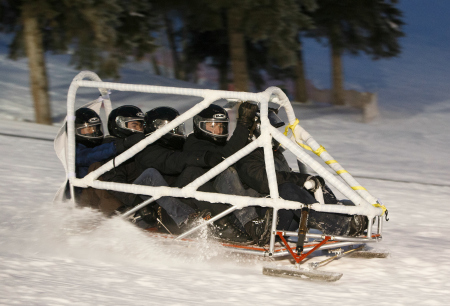
NEED FOR SPEED: The UAlberta GNCTR team puts its new sled through the paces in a pre-competition test run. The engineering student team is competing at the Great Northern Concrete Toboggan Race in Winnipeg Feb. 8 to 12.
(Edmonton) From conception to construction, it took the University of Alberta Great Northern Concrete Toboggan Race team nine months to build a sled they'll race against 25 schools from across Canada at a national engineering competition.
"It's really like having a child," said Brittney Lopushinsky, a fourth-year civil engineering student and Great Norther Concrete Toboggan team design executive.
And it took a team to 'raise' the concrete sled.
Based in the Department of Civil and Environmental Engineering, the GNCTR family reflects the interdisciplinary nature of the project and comprises 27 engineering, arts, business, and science students who put their heads together to design, build, and race the toboggan. Their project will be tested for speed and agility on the slopes in Winnipeg at the Great Northern Concrete Toboggan Race February 8 to 12.
"It's the camaraderie and the spirit of teamwork that makes this project so special," said Lopushinsky.
Smooth and sturdy, this year's toboggan looks nothing like its predecessors.
"We build a new sled every year," said Gregory Nieberding, Faculty of Engineering alumnus and the team captain who joined the project in his first year of school.
"The sled is a complete 180 of last year's design," added Lopushinsky.
Inspired by a snowmobile, the sled now features four skis instead of six, a handlebar, and a brand-new braking system. Improving upon last year's concept where the sled's rear would drop in the snow to stop, the team built metal plates that fall forward causing the sled to slowly brake.
"We opted for a smoother stop instead of having 280 pounds drop in the snow," said Lopushinsky of the revamped braking system.
Smaller in size, the new sled has shed some weight and is now equipped with air suspension, allowing it to 'glide' over bumps.
All competing toboggans have to pass a rigorous safety inspection prior to racing and rules state the sleds cannot exceed 300 lbs. Gliding surfaces must be concrete. But Nieberding says the design requirements still leave plenty of room for creativity. "The rules are so open it allows us to be innovative."
One way of doing it is by playing with the concrete mix used for the construction of the sled's ground-touching surfaces. This year, the chosen 'ingredients' reinforced the sled in multiple directions.
"Concrete's where we can flex our sustainability muscles," added Nieberding. Last year, the team threw shattered glass found in the dumpster into the mix.
Throughout its long history of concrete toboggan races, the U of A team has attracted multiple sponsors eager to help out. This year, the most expensive part of the project, welding, was done for free by one of them.
Engineering the sled's look is as important as streamlining its braking system, said Daniel Serediak, a fifth-year mechanical engineering student and a technical display executive with the team. Following this year's theme, 'Monty Python and the Quest for the Holy T-bog', the U of A team-as well as the sled-will be wearing custom-made costumes.
The GNCTR is the largest student-led engineering competition in Canada bringing over 500 engineering students from across the country, the U.S., and Europe every year.
"You get double-faceted learning where you pick up technical skills and get hands-on experience," said Serediak.
"It's the team spirit and the fun of it that make me come back every year," added Lopushinsky.